How to Increase VO2 Max: Counterintuitively Thinking
“The third-rate mind is only happy when it is thinking with the majority. The second-rate mind is only happy when it is thinking with the minority. The first-rate mind is only happy when it is thinking.” A. A. Milne
Today, I’m using a single counterintuitive thought to explain what causes VO2 max to increase in humans. First off, here’s the thought:
- Depriving your muscle cells of oxygen during high intensity exercise causes the cell to adapt to use more oxygen under the same intensity and conditions in the near future.
In other words, to increase your body’s maximum capacity to use oxygen, you must force cells to work at an exercise intensity near the point where aerobic metabolism fails to provide more power to increase exercise intensity.
The section of a VO2 graph where aerobic metabolism no longer contributes to the extra speed or power is shown by the arrow below.
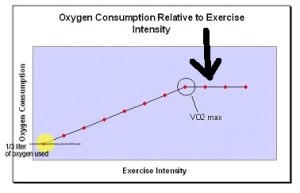 The entire horizontal shows intensity increasing – while the combustion rate in a cell no longer increases, which means O2 consumption remains the same. The exact point this begins is circled.
The entire horizontal shows intensity increasing – while the combustion rate in a cell no longer increases, which means O2 consumption remains the same. The exact point this begins is circled.
VO2 max just means combustion of acetic acid and O2 consumption have maxed out. In terms of making fire, the fire can’t get bigger and no additional CO2, water, or heat get made. The only way for your muscle cells to provide additional power must now come from another source.
Therefore, Sherlock Holmes style deduction tells us that the cell’s extra source of speed or power must be provided anaerobically – since combustion has maxed out.
Recall the thought experiment from day 1, which concluded with the fact you can run very fast or sprint without ‘breathing’. A cell does not need to respire to move your body repetitively at a high intensity or produce instantaneous maximum force.
But keep in mind when anaerobic power ‘kicks in’ to increase intensity past VO2 max, the cell is still ‘breathing’ or combusting fuel – it’s just that aerobic metabolism can’t produce super bursts of speeds – while anaerobic power indeed can.
Thus, aerobic metabolism is a ‘less explosive way’ to power muscles. Anaerobic metabolism is more explosive.
Visually – using the cell models, where candles represent the amount of aerobic power at VO2 max and darkening the yellow food colored water represents increased anaerobic power past VO2 max – the ‘speed kick’ transition in the cell looks like this:
This demonstrates your cells have two different ‘metabolic parts’. The aerobic part, mitochondria combust fuel – and the anaerobic section cytosol does not. Most people hear, ‘mitochondria is the powerhouse of the cell’ – which in terms of exercise intensity is flat out misleading and wrong. Fermenting glucose in the cytosol provides far greater power, although it is short lived when acidity increases with the cell and slows/shuts it down.
I use yellow food colored water to depict the rate at which the cytosol ferments glucose, which produces acid. High rates of fermentation in the cytosol explains why you can increase speed or intensity past VO2 max – and why lactic acid simultaneously increases in blood during intense exercise!
Now when it comes to metabolism of food stuffs – your cells are powered by two forms that produce two different waste products – so get clear on this detail right now:
1. When combustion of fuel provides the power… CO2 + H2O + Heat are the waste products.
2. When anaerobic power transforms glucose… acid is the resulting waste product. This acid spills into your blood from the muscle just as CO2 exits the cell.
When we do a lactate test later, we will measure this acid production. We will not examine fermentation and acid production in detail now; what you have seen is only a seed to clarify your thinking that only two forms of metabolism exist. We now return to examining oxygen used during rest and exercise.
Interpreting VO2 max and speed limitations on a simple VO2 graph.
In the sloped line of the graph your cells are never short of oxygen as they continually increase consuming O2 and your body speeds up. The part of the VO2 graph that reflects when your cells are relatively deprived of oxygen is the flattened out part.
The point where a VO2 graph flattens out indicates two things:
1. The velocity or intensity where VO2 max begins. This is termed vVO2 max – indicated by the circle.
2. The point where extremely high rates of fermenting glucose provides the extra power for muscles.
vVO2 max represents the slowest velocity or intensity your body performs at VO2 max. All greater speeds or intensity past this velocity are powered by extremely high rates of carbohydrate or glycogen depletion – or more specifically fermentation of glucose. The higher the rate of fermentation, the more acid spills into the blood out of the cell.
Aerobic metabolism is not as explosive as anaerobic metabolism. Without the ability to ferment glucose, elite humans would be limited to running a top speed around 13mph as opposed to Usain Bolt’s top speed of 27mph.
Although we all are conditioned to think combining fuel and oxygen results in fire or explosions – it important to realize the anaerobic section of your cell is even more explosive than the mitochondria! Anyway the point is you, me, and most anyone can increase speed past the point where combusting fuel and O2 consumption max out.
So most definitely, if only aerobic power energized your muscles, you’d not only see no increase in speed while running at VO2 max, you would not be able run a few fast breaks in a row in basketball, run around a lake at a good clip, lift weights to failure around 12 reps, etc. All this is powered by fermentation. Why do you think you fail at 12 reps if that’s your goal? High acidity within the cell very quickly shuts it down – forcing you to stop or slow down.
When a cell works past its vVO2max you are placing it under extreme stress to speed up. Thus, you are challenging the anaerobic part of your cell, and at the same time forcing the aerobic part to adapt.
Below: another rendition of acid building up in the cytosol as a result of high intensity exercise.
VISUALIZING AN INCREASE IN VO2 MAX
The increase of VO2 max in a human (graphed) look like this:
The increase of VO2 max – or the adaptation in a human’s cell that increases its capacity to use more oxygen, i.e. adding mitochondria looks like this:
 The ‘trained’ cell on the right basically has a higher capacity to use more oxygen.
The ‘trained’ cell on the right basically has a higher capacity to use more oxygen.
Using our candle cell models, we simply add more candles to represent what the physiologist calls greater mitochondrial density. Now the cell can use more oxygen because it’s sort of like we replaced a small Weber Grill with a larger one.
Any cell or engine with a higher VO2 max can utilize more fuel and oxygen – for example an engine with larger cylinder capacity, e.g. a 5.0 liter engine uses more fuel and oxygen compared to a 1.6 liter engine.
MAIN POINTS:
- No matter the size of the aerobic engine or a person’s VO2 max – only anaerobic power provides the burst/speed power to lift weights for say 12 reps to failure, run fast breaks, run around a lake at a good clip, etc. This is very stressful on a cell – and therefore on your body.
- As you ‘go past’ vVO2 max you stay at VO2 max. From this point you continue to use the same amount of oxygen – as shown by the leveling off of the graph.
 At all speeds past vVO2max, the cell oxygen based power has maxed out – and so the only way for the cell to produce faster spurts is through extreme rates of fermenting glucose.
At all speeds past vVO2max, the cell oxygen based power has maxed out – and so the only way for the cell to produce faster spurts is through extreme rates of fermenting glucose.
Advanced Section
VISUALIZING ACID PRODUCTION and INCREASED OXYGEN POWERED ABILITY
The sequence in which I placed the cell models show how high rates of fermentation force a cell to adapt and ‘get in better shape’ to use oxygen.
The cell of an untrained or out of shape person has 3 mitochondria. It produces very little acid at rest and look like this:
Say we force the cell to work hard at a ‘speed’ of 4.2 m/sec. (Illustrated in lesson 24 in The Physical Rules book) Given that it has only three candles, we are saying this person has small or weakened aerobic capacity or low VO2 max. Despite the person’s low aerobic capacity we know the outer part of the cell can provide bursts of speed – and when it does, it looks like this:
 The dark yellowish color represents high acidity from extreme fermentation.
The dark yellowish color represents high acidity from extreme fermentation.
The cell is operating under an ‘oxygen debt’ – meaning it’s not getting enough O2 to supply the power – and resorts to a ‘crazy high level’ of fermentation.
If the cell had a larger aerobic engine, it would have used less fermentation to produce the same level of power – which is the case with the next cell shown below.
Here’s the kicker. Because the cell with a weakened VO2 max potential above WAS STRESSED (unable to use a high level of combustion to produce higher power) – this is actually a good thing for the cell – for it stimulated the cell to adapt and build more mitochondria. This adaptation looks like this when running the same speed (4.2 m/sec):
This trained or adapted cell runs at 4.2 m/s sec as the untrained cell did.
It now uses less fermentation to produce the speed, as indicated by the lighter colored water.
WHAT IT REALLY MEANS TO ‘GET IN SHAPE’
The difference between people ‘in shape’ and ‘out of shape’ is their ability to use more oxygen by way of combustion with less dependence on fermenting glucose as exercise intensity increases. When each person works at fairly high but identical intensity the in shape person’s cells use a greater degree combustion, which simultaneously decrease the rate of fermentation and acid production.
- Both people can produce the same speed or power – but the tradeoff between the source of power contributing to the whole differs.
When you stress or train your muscles by way of high intensity fermentation you cause your cells to adapt – because they prefer to use oxygen rather than not. So the next time you stress it out the same or in a similar enough way – you will not fatigue as quickly because you produce less acid. You can handle the stress better.
So, in an untrained person – extreme stress to a cell happens quicker – sooner – at lower intensity levels. Again, this means high rates of fermentation occur later, at higher intensity levels in a trained person.
Watching someone get tested in a VO2 max test.
When we test Gio, we’ll expect to see him laboring and feel tired before he’s reached his VO2 max.
Like anyone else at the early stage of exhaustion he’ll keep on running faster past the point he reaches his VO2 max – for three reasons:
- Regardless of fitness levels everyone can work past their VO2 max.
- Many people are fairly exhausted or laboring before they reach vVO2 max. It is necessary to push to utter exhaustion, because the only way to know you have reached VOsmax is to keep running faster past vVO2max. The tester sees the O2 readings level off or drop. Then the test is done.
- Gio’s expectation will be to run like hell, which is exhaustive.
If running is the exercise used to test VO2 max it is easy to think you’ll end up running as fast as possible, i.e. end up sprinting – which is not the case. It’s just that if you have been running hard already before reaching vVO2 max – then pushing past this point is super exhausting.
- It’s easier to sprint from a fresh (but warmed up) rested state – and far less exhaustive – compared to running during a VO2 max test.
NOTE: We can test our expectations tomorrow as well as my prediction below. This is an educated guess on my part:
- The point where we see Gio physically laboring will coincide running near 57% of his VO2 max – plus or minus 5%.
Past 57% of his vVO2 max he’ll continue to run faster (or harder at incrementally higher inclines) to the point he’ll call it quits. We will not know this until we look at the data. The tester’s machine will kick out data for us to compare his actual VO2 (volume of O2) to his speed. We’ll use this raw data to verify my guess and for calculating other cool stuff later.
What does running at 60% of VO2 max look like on a graph?
At 60% of his VO2 max , draw a point or a line that crosses the slope 60% of the way up the line between 0 and where it levels off at 100% VO2 capacity.
At 75% of VO2 max you do place the position on a VO2 graph 3/4 of the way up the slope from zero to 100%. Like this:
Where would you place running at 105% of VO2 max?
Coming full circle: Rewording and rethinking the counterintuitive thought.
- High intensity exercise powered without oxygen causes a cell to increase its oxygen powered capacity.
- Extremely high intensities are unsustainable mainly due to production of vast amounts of acid.
- Fairly high intensities are more or less sustainable depending on pace, intensity, and training regimens, e.g. interval training, running at certain paces at either shorter or longer dsitances. Training at the ‘sweet spot’ intensity or ‘dosage’ is the key to elevating VO2 max, which decreases excessive fermentation and high acid levels.
- The correct dosage of intensity or ‘stress/speed’ stimulates a cell to add more ‘fireboxes’ or mitochondria.
- Many coaches and athletes look for a holy grail of training dosages, meaning they often look for new ways or develop new strategies to train under the ‘ideal’ stress zones or exercise intensities.
But make no mistake – oxygen deprivation or an oxygen deficit – which occurs when forcing cells to ferment sugar at high rates – is the true stimulus for your body to create ways for a cell to use more oxygen. A cell that rebuilds itself to maintain higher rates combustion is a cell that decreases its rate of fermentation.
You may come across, writers, coaches or researchers who say you cannot increase your VO2 max and others who say you can. Neither camp is wrong and both are right. Here’s how to reconcile this.
Consider an untrained, sedentary or out of shape person whose VO2 max graph looks like the red dotted line below, but after a year’s worth of training, their VO2 graph looks like extended black dotted line.
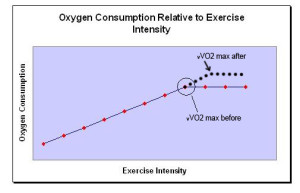 Obviously their max O2 intake has increased.
Obviously their max O2 intake has increased.
Now let’s say the person diligently trains for 2 more years with decent coaches but his or her VO2 max hasn’t budged. We could then say the person has reached their potential.
This is the ‘god-given genetic’ component – the predetermined blueprint that made the ‘individual machine’.
Reaching one’s greatest potential is a peak condition – one that by very definition is NOT maintained but only achieved momentarily. Many elite endurance athletes may remain near their genetic potential or maximum VO2 potential/capacity during the competitive years of their careers. Therefore training does little to change their peak since they remain always near the peak.
Boxers, runners, body builders, football teams and the players all hope to peak on the day of the event because they know being in top condition at the right moment is the required condition – albeit ephemeral – for success.


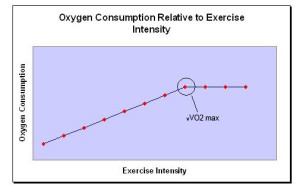
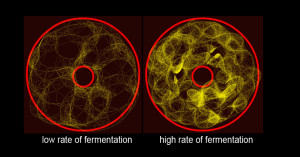


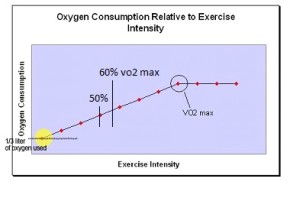
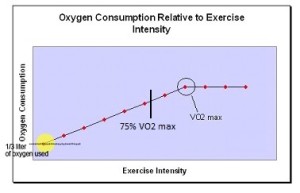
OUTSTANDING Post.thanks for share.